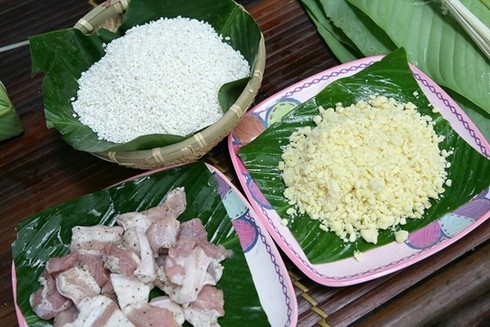The Giay are known to have many festivals during the year, including the Mid-autumn festival, new rice festival in the ninth lunar month, and the Day cake making festival in the tenth lunar month to finish their crops.
Among them, the Lunar New Year festival or “Xieng lao,” as called by Giay people, is the most important one. Giay people’s New Year celebration has many unique rituals and special dishes.
All the members of Ms Luc Thi Nhinh’s family in Ta Phoi commune, Lao Cai city often get up early in the morning on the last day of the year to clean and decorate their house. Everything in the house – the hoe, the plough, plants and the altar – are covered with red papers to welcome the New Year.
Giay people believe that red paper symbolizes happiness and good luck. Apart from decorating with red paper, they also make glutinous rice for the New Year.
Ms. Nhinh said the Giay’s glutinous rice cakes are in a lozenge shape with two tapered ends. They also call it a hump cake. It is essential to carefully choose materials to make good cakes. The wrapping leaves must be picked in the forest and at a medium size.
The best quality glutinous rice is chosen and green beans are husked. Mixed in is lean and fat pork sliced and seasoned with different kinds of spices, including cardamom. When all the ingredients are ready, the cake wrapping process begins. The cake should have a nice lozenge shape and each cake should have three layers – rice, green beans, and pork.
Ms. Nhinh said, “The hump cakes are made twice a year, before the Lunar New Year and after the first lunar month. We make a set of 3 hump cakes to worship the ancestors on the occasion of the New Year”.
Puffed rice is also must-have at a party or New Year celebration of the Giay people. They select round, uniform grains of rice to make the best puffed rice. Roasted rice blended with sugar is molded in a big bowl.
The cakes have the aroma of glutinous rice, molasses, and ginger. Cakes made from glutinous rice powder are often served at New Year parties or given to relatives and friends as gifts.
Beside cakes, the Giay people make colored sticky rice in the New Year. The colors of the sticky rice differ according to different occasions in the year. For the Lunar New Year festival, the Giay people make purple sticky rice. The purple color is taken from wild leaves collected from the forest.
The leaves are crushed, boiled and filtered in water to soak the rice. After several hours, the rice is steamed. Ms. Nhinh said, “We only use one color for the New Year sticky rice. We use 3 colored sticky rice for the third lunar month festival and 7 colored sticky rice for the festival in the seventh lunar month”.
Khau nhuc is another popular traditional dish of the Giay people made the occasion of the New Lunar Year. Khau nhuc is made from fat and lean meat and is a time-consuming and meticulously prepared dish.
The meat is boiled for a while, then cooled down. The skin of the pork is cleaned before marinating. The pork is marinated with different kinds of spices and honey, then fried.
Mr. Nong Van Truong from Ta Phoi 1 hamlet, said, “Giay people usually make Khau nhuc to offer to the ancestors on the first day of the Lunar New Year”.
The New Year banquet of the Giay people is abundant with hump cakes, colored sticky rice, and Khau nhuc. Everyone toasts one another a happy new year.
The Giay ethnic people celebrate the New Year with a drum dancing festival to pray for a prosperous and happy new year. The drum dancing festival is held in the early morning of the first day of the Lunar New Year.
Mr. Phan Van Thao, head of Na Trao hamlet, Ha Giang province, said that for the Giay people, the drum is a sacred object that brings good luck to everyone. The drum is kept at the Mieu Ba – a local temple for 11 months and is only used in the first lunar month.
Mr. Thao said, “The drum dancing festival is held once on the occasion of the Lunar New Year. The drum must be kept carefully in the village temple for the whole year. Only in urgent cases like natural disasters, can the drum be used for worship rituals”.
Preparation for the drum dancing festival usually begins in the early morning of the first day of the New Year. A shaman accompanied by unmarried men make preparations for a ritual to lower the drum from Mieu Ba temple and bring it to Mieu Ong temple for the festival.
Mr. Thao added, “The drum is considered sacred to us. The drum is not arbitrarily moved or lowered because such an action is considered disrespectful to god”.
After the drum is brought to Mieu Ong temple, all the villagers gather around the drum and wait for the shaman to carry out the ritual offering and ask the God for permission to lower the drum. First, the shaman invites the deity back to witness the village ritual. He then reports the achievements the village has made in the past year and asks the deity to bless the village in the new year.
The main offerings to the deity are agricultural products. The shaman also prepares some words to hang at the village temple. Apart from that, each family makes a tray of offerings.
Mr. Thao noted, “When all the villagers are present at the village temple, the ritual starts. The village has an offering tray which includes 3 incense sticks, a bowl of peanuts, a chicken and 2 square sticky rice cakes”.
After the ritual, the shaman writes villagers’ wishes on the drum head, then beats the drum to start the drum dancing festival.
Mr. Thao said, “The shaman beats the drum three times. He uses a branch of lemon leaves and a bowl of water, says some magic words and sprays water over the drum. The shaman is the first to beat the drum, then come others”.
Mr. Lo Quang Sai from Tat Nga commune said the magic drum can be lowered from Mieu Ba temple once a year. The Giay people believe that the drum helps them to carry their prayers to their ancestors: “The loud sound of the drum is believed to bring a new year of health, prosperity and luck. Every spring, children and adults are all excited at the ritual to lower the drum. Everyone tries to strike the drum for good luck”.
The drum is 1 meter high and has a diameter of more than 60cm. The drumheads are made of leather. The drum is made of iron, wood or jackfruit wood. Mr. Sai again: “The drum is made of jackfruit wood because the jackfruit tree has flower patterns while the fruit symbolizes fertility and bumper crops. We hope to have a successful new year”.
After some rituals are carried out by the shaman, the drum will be passed around the village. When passing through a house, the drum will be beaten to sound a prayer for peace and luck for the owner of the house. After that, the drum dance ritual begins.
The drum dance festival is a unique aspect of the Giay culture in Ha Giang. The festival takes place in front of Mieu Ong Temple. The drum is carried by the healthiest young people in the village, followed by others lining up to create an atmosphere of solidarity and joy.
Mr. Phan Van Thao said everyone, locals and visitors, can join the drum dance: “At first, 5 or 6 professional couples will start the drum dance. It will be followed by other people, creating a long line”.
Mr. Lo Quang Sai said, “The traditional drum dance has been handed down through generations. The more people join in, the more joyful the dance is”.
Mr. Sai added the person who beats the drum plays a decisive role. He is compared to “ a conductor of an orchestra”. Normally, an elderly person who has good knowledge about drums is chosen to strike the drum.
Mr. Sai said, “This person will decide the rhythm of the drum dance. In the first rhythm, young couples start dancing. With the second rhythm, people cheer up. With the third rhythm, people start working. This symbolizes the cycle of the year”.
Young boys and girls in traditional costumes join the dance. The line is getting longer and longer with more people participating. Every one dances to pray for a lucky and happy year. At the end of the festival, the villagers come together to bring the drum back to the temple and wait until the festival next year.




